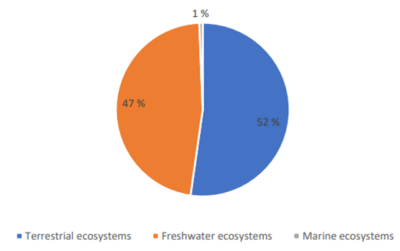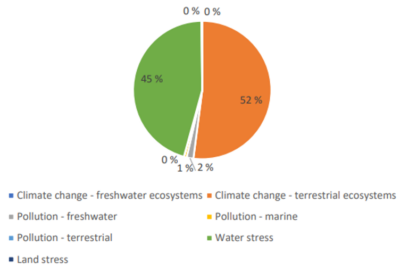Up to one-third of biodiversity loss is due to construction
Granlund and Skanska piloted biodiversity impact calculation in the NSDC initiative
Carbon footprint calculation is already commonly conducted in construction projects. Climate change is a significant contributor to biodiversity loss and, hence, it is good that carbon emissions are already monitored and mitigated. However, there are four other contributors to biodiversity loss, which are water stress, pollution, land use and transformation, and invasive species. More comprehensive consideration of overall biodiversity impacts is needed since construction has a significant impact on global biodiversity loss. The construction sector is responsible for up to 30 % of biodiversity loss.
The biggest share of the biodiversity impacts occurs outside of the building site. Raw-material extraction from nature, material production, and transportation, it all impacts biodiversity. Hence, the biodiversity impacts of the whole life cycle of a building need to be measured, from raw material extraction to the end of life of the building. Biodiversity impacts can be calculated by LCA in combination with methods that quantify different impact categories’ damage to ecosystems. The biodiversity loss and the reduction of ecosystem diversity can be assessed using the PDF unit (Potentially Disappeared Fraction of Species). PDF indicates the proportion of potentially disappearing species lost globally as a result of an activity or environmental change.
The calculation of embodied biodiversity impacts of a building was further researched and piloted in the NSDC initiative. Biodiversity impacts were calculated for an apartment building, constructed by Skanska using the LC-impact method. Embodied biodiversity impacts were calculated for a building, reportedly for the first time in Finland.
The results of the calculation show that, the case building has 2.10 nPDF*y(* impact on terrestrial ecosystems, 1.89 nPDF*y impact on freshwater ecosystems, and 0.03 nPDF*y impact on marine ecosystems. Climate change is the biggest driver of biodiversity in the case building (52 %), with water stress being the second biggest driver (45 %). Land stress and pollution have a lower impact on biodiversity in the case building (3 %).
Due to the impacts of climate change, the construction of the case building impacts mostly terrestrial ecosystems. Moreover, due to the impacts of water stress, the impacts on freshwater ecosystems are high as well. Impacts on marine ecosystems are less significant. The case building is a concrete framed building, and hence concrete and reinforcing steel were the most impactful materials in most of the categories. In the land stress category wooden materials, such as wooden internal doors have the greatest impact.
The research conducted in the NSDC initiative gathered a great amount of valuable information on methods for biodiversity impact calculation, biodiversity impacts of a building and different building materials. By calculating the impact on biodiversity throughout the entire life cycle of a building, it is possible to compare the effects of different actions on biodiversity. The calculation of biodiversity impact can be added to the toolkit for assessing the overall sustainability of buildings.
(* PDF = Potentially Disappeared Fraction of Species
nPDF = Results are demonstrated in nano PDF units, since PDF usually gives very small values since it describes the impact of one building on global biodiversity loss, hence prefix nano is used.
Do you want to know more?
 Emma Väliaho
Emma Väliaho
Environmental specialist
Granlund
Charlotte Nyholm
Chief specialist
Granlund
https://www.granlund.fi/blogi/jopa-kolmannes-luontokadosta-johtuu-rakentamisesta/


